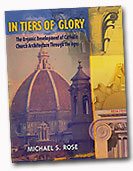 Michael Rose’s recent book: In Tiers of Glory: The Organic Development of Church Architecture Through the Ages, offers exactly what it promises, “an easily understandable overview of the history of Church architecture.”
Michael Rose’s recent book: In Tiers of Glory: The Organic Development of Church Architecture Through the Ages, offers exactly what it promises, “an easily understandable overview of the history of Church architecture.”
Admittedly, Mr. Rose’s approach is not a scholarly one intended for the historian, but a well-articulated tracing of the development of Church architecture that is easily within the grasp of the layman. This allows him to reinforce his thesis, without getting bogged down with the endless details which often render such works dry and uninspiring.
Mr. Rose argues that Church buildings are “vessels of meaning…that must bear the significance of eternal truths through material forms to establish a sacred place destined for divine worship.” Since the truths these structures must signify are eternal, the development of Church architecture should develop organically and never break suddenly with the past. Thus, in spite of changing styles, the continuity of church architecture will “manifest the permanence of the Catholic Faith.”
In fact this is exactly how church architecture did develop. Beginning with the earliest churches of history, the design of the Church sanctuary, which officially separates the profane from the Sacred, was modeled on the design God gave to Moses for the tent which housed the Arc of the Covenant during the Jewish exodus. Once the Roman persecutions ended with the Edict of Milan, the early Christians were allowed to climb out of the catacombs and build Churches for public worship. They imported this sanctuary design into the front of the finest house design that existed at the time, the basilica.
This basilica design was characterized by a rectangular shape. In the center was a larger area with a narrower passageway on either side of it. The most notable change made to this design, was the addition of two “arms” towards the front of the structure, making the floor plan into the shape of a cross. This became known as the “cruciform” design. The result was the first churches of the early Christian centuries.
Until roughly the fifties, this basic design was the standard for Church architecture. Throughout the ages, different artist styles came in and out of vogue, for example in the Middle Ages, the Romanesque style with its curved arches and heavy columns was replaced by the Gothic which innovated pointed arches, taller structures and lighter columns, but no change represented a sharp break with traditional designs.
In fact, from the time of the original basilicas, the same design was improved and developed, until the Renaissance which shelved emerging styles in favor of ancient Greek and Roman ones designed on the proportions of the human body. Attempts to change the traditional cruciform shape of churches during this time and later in the Baroque period, never substantially took hold.
Understanding the development of Church architecture in this light, makes one marvel at the permanence and constancy of the Catholic Faith, but it also raises profound questions about modern churches, many of which stand in razor-sharp contrast to their predecessors.
Mr. Rose shows how these modern structures are built with the “first tenet of Modernism in mind: “the need to break with the past in order to create a so-called ‘new architecture for modern man.’” Unfortunately for modern Catholic men, this break with the past leaves no room for those eternal truths defended by the Church for two thousand years.
One characteristic of this Modernistic church architecture is a utilitarian design that strives to separate itself from the Faith. Santiago Calatrava, an architect whose design initially won the contract for the Cathedral of Oakland, unabashedly expressed this desire. “My ambition,” he stated, “is to give Oakland’s cathedral a universal character independent of the Catholic Church.”
Although Mr. Calatrava later lost the contract for the Cathedral in favor of an architect known for his design of American skyscrapers, his comments are significant to show the type of thinking in vogue among modern Church architects.
That is not to say that traditional church architects no longer exist. Mr. Rose explains how some architects are currently trying to remake the link with the past. For example, Duncan Stroik’s design for the Chapel for St. Thomas Aquinas College, is truly inspiring.
Amply embellished with nearly 200 photographs, In Tiers of Glory is a book that one hardly needs to read. The author’s thesis is spelled out clearly as one thumbs through centuries of beauty and grandeur, only to be shocked at the end by what currently passes for a church.
Although not written for the scholarly historian, it is a must read for the lay observer who has marveled at the beauty of Churches from bygone days, then looked at their modern counterparts and wondered what happened.
Paperback: 136 pages
Publisher: Mesa Folio (November 15, 2004)
ISBN: 0967637120

